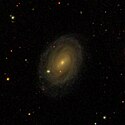IC 213
| Galaxie IC 213 | |
|---|---|
 | |
| SDSS-Aufnahme von IC 213 | |
| AladinLite | |
| Sternbild | Widder |
| Position Äquinoktium: J2000.0, Epoche: J2000.0 | |
| Rektaszension | 02h 14m 04,3s[1] |
| Deklination | +16° 27′ 21″[1] |
| Erscheinungsbild | |
| Morphologischer Typ | SAB(rs)b[1] |
| Helligkeit (visuell) | 13,8 mag[2] |
| Helligkeit (B-Band) | 14,6 mag[2] |
| Winkelausdehnung | 1,9′ × 1,5′[2] |
| Positionswinkel | 150°[2] |
| Flächenhelligkeit | 14,8 mag/arcmin²[2] |
| Physikalische Daten | |
| Zugehörigkeit | LDCE 151[1] |
| Rotverschiebung | 0.027396 ± 0.000017[1] |
| Radialgeschwindigkeit | (8213 ± 5) km/s[1] |
| Hubbledistanz H0 = 73 km/(s • Mpc) | (370 ± 26) · 106 Lj (113,5 ± 7,9) Mpc [1] |
| Durchmesser | 205.000 Lj[3] |
| Geschichte | |
| Entdeckung | Stéphane Javelle |
| Entdeckungsdatum | 29. Dezember 1893 |
| Katalogbezeichnungen | |
| IC 213 • UGC 1719 • PGC 8556 • CGCG 461-067 • MCG +03-06-046 • 2MASX J02140427+1627212 • 2MASS J02140429+1627211 • | |
IC 213 ist eine Balken-Spiralgalaxie vom Hubble-Typ SBb im Sternbild Widder nördlich der Ekliptik. Sie ist schätzungsweise 370 Mio. Lichtjahre von der Milchstraße entfernt und hat einen Durchmesser von etwa 205.000 Lj.
Im selben Himmelsareal befindet sich u. a. die Galaxie IC 212.
Das Objekt wurde am 29. Dezember 1893 vom französischen Astronomen Stéphane Javelle entdeckt.[4]
Weblinks
Einzelnachweise
Auf dieser Seite verwendete Medien
Autor/Urheber: Sloan Digital Sky Survey, Lizenz: CC BY 4.0

Angle of view: 4' × 4' (0.3" per pixel), north is up.
Details on the image processing pipeline: https://www.sdss.org/dr14/imaging/jpg-images-on-skyserver/